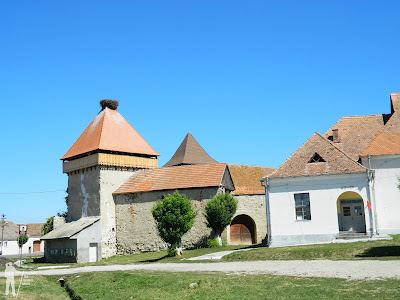Povestind despre vizita pe la bisericile fortificate săseşti, naşul părinţilor mei mi-a spus: "păi şi nu aţi mers până la Caţa? Eu-s de-acolo. Katzendorf, îi zicea pe nemţeşte. Dar bine, eu sunt dintr-un sat românesc de lângă, Paloş."
Nu fusesem în Caţa, pentru că trecusem pe drumul principal şi virasem spre Viscri, dar acum că am vizitat Homorodul, am mers din curiozitate mai departe să vedem Caţa şi Paloş.
Am descoperit un sat foarte obişnuit, centrul fiind foarte îngrijit şi prevăzut cu un parc, împrejmuit astfel încât să nu pătrundă animalele oamenilor. Lângă parc este o casă superb restaurată, dar am mai văzut şi altele. Biserica fortificată este micuţă şi am decis să o sărim.
La ieşirea spre Paloş am dat de altă clădire care mi-a stârnit mult mai mult interesul: şcoala sătească construită într-un stil neoromânesc rural! La intrare are un turn tip culă, dar mai ales o frumoasă colonadă ce împrejmuieşte curtea. Nu aş fi bănuit niciodată că un sătuc anonim ascunde o astfel de clădire singulară, ce încă posedă toate elementele (exterioare) originale. Sper din tot sufletul să conştientizeze valoarea ei şi să o păstreze aşa.
Caţa
Talking about our tour to visit the Saxon fortified churches in southern Transylvania, my parent's godfather told us: "you didn't see Caţa? I'm from there. Katzendorf, it used to be called in German. Well, not from the that village, a smaller neighbouring Romanian village, Paloş."
We did not visit Caţa, as we went on the main road then on to Viscri, but this time being in Homorod, we pushed on to the next villages, Caţa and Paloş.
Caţa is quite ordinary, but with a neat center and even a fenced park (to prevent farm animals from grazing). Next to it is a beautifully restored house, but I have seen others as well. The Saxon fortified church is small, so we decided to skip it.
It's while driving towards Paloş that we saw what really caught my attention: the village school in rural Neoromanian style! Its entrance is a "cula" like tower and the courtyard has a Neoromanian colonnade. I would never have thought that a small village would have such a rare building like this, with all its original elements intact, on the exterior at least. I really hope the village realizez they have a small jewel there and keep it in good condition.
Nu fusesem în Caţa, pentru că trecusem pe drumul principal şi virasem spre Viscri, dar acum că am vizitat Homorodul, am mers din curiozitate mai departe să vedem Caţa şi Paloş.
Am descoperit un sat foarte obişnuit, centrul fiind foarte îngrijit şi prevăzut cu un parc, împrejmuit astfel încât să nu pătrundă animalele oamenilor. Lângă parc este o casă superb restaurată, dar am mai văzut şi altele. Biserica fortificată este micuţă şi am decis să o sărim.
La ieşirea spre Paloş am dat de altă clădire care mi-a stârnit mult mai mult interesul: şcoala sătească construită într-un stil neoromânesc rural! La intrare are un turn tip culă, dar mai ales o frumoasă colonadă ce împrejmuieşte curtea. Nu aş fi bănuit niciodată că un sătuc anonim ascunde o astfel de clădire singulară, ce încă posedă toate elementele (exterioare) originale. Sper din tot sufletul să conştientizeze valoarea ei şi să o păstreze aşa.
Caţa
Talking about our tour to visit the Saxon fortified churches in southern Transylvania, my parent's godfather told us: "you didn't see Caţa? I'm from there. Katzendorf, it used to be called in German. Well, not from the that village, a smaller neighbouring Romanian village, Paloş."
We did not visit Caţa, as we went on the main road then on to Viscri, but this time being in Homorod, we pushed on to the next villages, Caţa and Paloş.
Caţa is quite ordinary, but with a neat center and even a fenced park (to prevent farm animals from grazing). Next to it is a beautifully restored house, but I have seen others as well. The Saxon fortified church is small, so we decided to skip it.
It's while driving towards Paloş that we saw what really caught my attention: the village school in rural Neoromanian style! Its entrance is a "cula" like tower and the courtyard has a Neoromanian colonnade. I would never have thought that a small village would have such a rare building like this, with all its original elements intact, on the exterior at least. I really hope the village realizez they have a small jewel there and keep it in good condition.





Comentarii
Trimiteți un comentariu